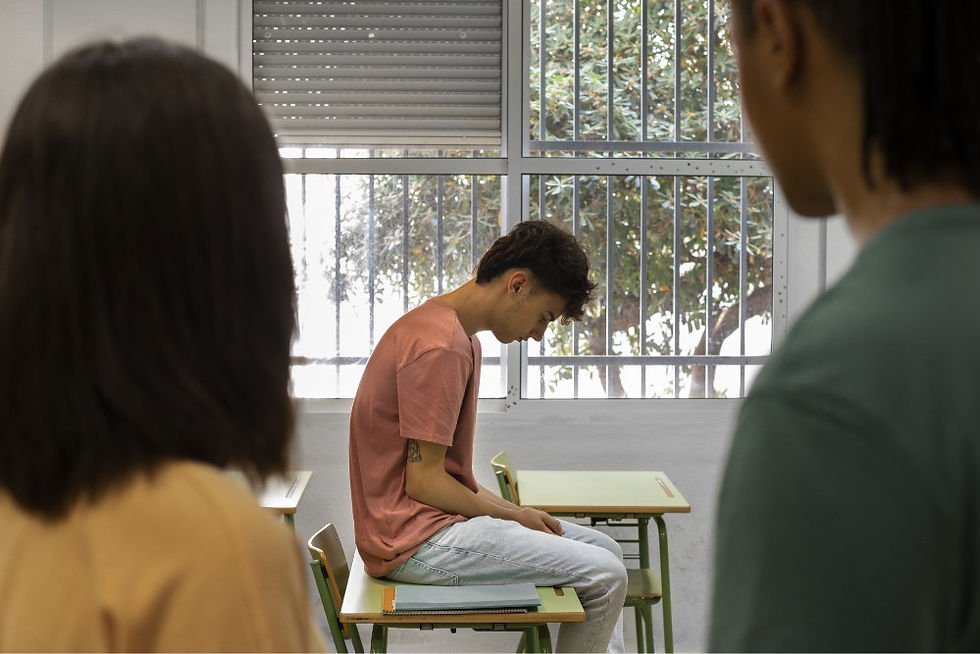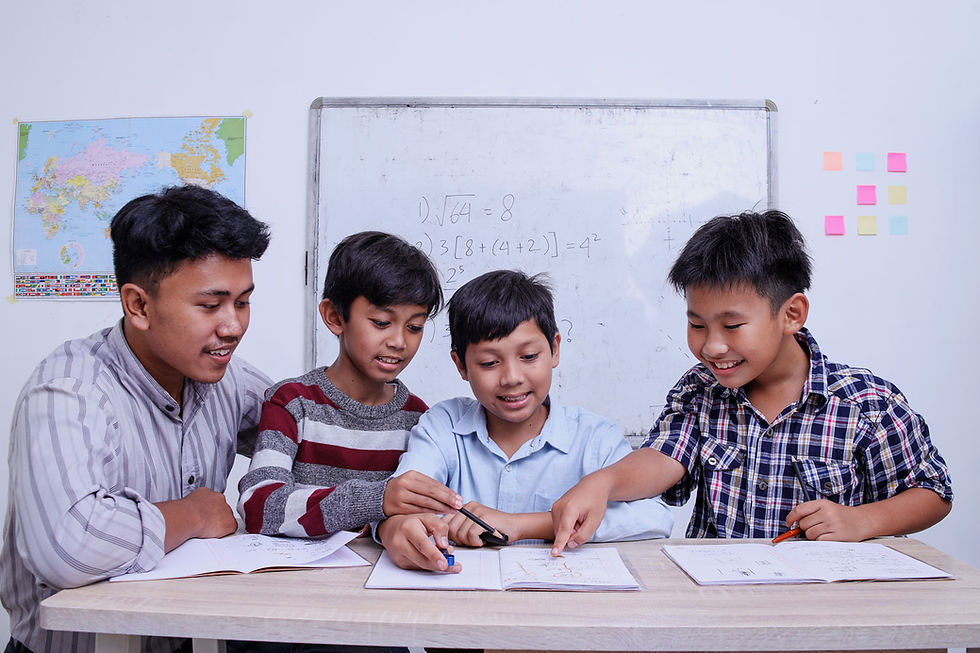How to Teach Children with Learning Disabilities
- SHINE Children and Youth Services

- Apr 22
- 6 min read
Updated: Sep 23

Supporting young students with learning disabilities can be rewarding and challenging. From challenges in following instructions to difficulties with reading or mathematics, each learning journey is unique, just like the child behind it.
But with the right strategies, tools, and mindset, meaningful progress is possible. The first step is to understand the student’s individual strengths, needs, and goals. From there, you can identify and apply evidence-based strategies that are best suited to their learning style.
To help young students with learning disabilities build confidence and achieve their potential, consider these teaching strategies:
Engaging the Senses to Make Learning More Fun
Engaging multiple senses, also known as multi-sensory learning, is a teaching strategy that combines different sensory inputs to help students with special needs understand and connect with concepts. This doesn’t mean using all the senses at once, but rather making thoughtful choices about which senses to engage for specific tasks. The goal is to make learning clearer, more relatable, and easier to grasp for every student.
1. Use Visual Supports
Some students with learning disabilities are visual learners, so using concrete and visual materials can be beneficial when teaching them new ideas and concepts. In maths, concrete materials, such as number blocks, counters, or visual number lines, support the development of numeracy by making abstract concepts more tangible and easier to understand.
2. Incorporate Music, Rhythm, and Touch
Music and rhythm can significantly support literacy by reinforcing phonemic awareness, rhyming, and word syllables. Singing songs that emphasise sound patterns or using clapping to break down syllables makes learning more memorable and fun.
Tactile learning is also powerful. Using textured letters or placing raised dots on numbers can help students feel their way through difficult concepts, especially in subjects like spelling or mathematics.
3. Use Brain Breaks for Better Engagement
Sometimes, taking in a lot of information can be overwhelming for children and youth with learning disabilities. Therefore, it’s important to mix learning with brain breaks to help them reset and refocus. Some simple ways to incorporate these include 30-second stretches between lessons or quick breathing exercises.
Providing Extra Supports and Strategies for Learning
Offering extra support to students with learning disabilities can make a meaningful difference in their academic and personal development. Some of the ways to do so include:
1. Encourage Self-Monitoring Skills
Self-monitoring refers to self-assessing behaviours and recording the results. Although it does not create new skills or knowledge, it does increase or decrease the frequency, intensity, or duration of an existing behaviour. Moreover, studies have shown that it helps students with attention difficulties increase their focus on a task and promote productivity.
One way to perform self-monitoring is to create structured checklists to assess their own work against a set of criteria. For visual learners, storyboards, drawings to showcase a storyline, can also help them plan out their tasks.
2. Promote Peer Tutoring and Group Work
Collaborative group work can also be beneficial for students with learning disabilities to develop positive social behaviours like teamwork, sharing and leadership. When implemented thoughtfully, it helps them develop positive social behaviours such as teamwork, empathy, and communication skills. For students with learning challenges, peer interaction can also provide additional opportunities to practise academic skills in a more relaxed and supportive setting.
Before pairing neurotypical students with peers who have disabilities, it's essential to introduce peer-mediated intervention. This involves teaching neurotypical students how to communicate respectfully and effectively with their peers who may learn differently. It's important to guide them on how to offer help without overwhelming the students with disabilities and how to respond with patience and understanding.
To ensure meaningful interaction, it's important for teachers or guardians to actively facilitate group activities. This includes setting clear goals, assigning appropriate roles, and creating a safe space where every student feels valued. With the right approach, strategies for teaching students with special needs can foster not only academic growth but also emotional and social development.
3. Teach Meta-Cognitive Strategies
Meta-cognitive strategies empower students with learning challenges to become more aware of how they take in information best. By explicitly teaching techniques such as rehearsal (repetition), elaboration (summarising), and using memory aids like mnemonics, they can develop tools to strengthen their learning process.
Incorporating regular opportunities for learning reflections further helps students with special needs discover which strategies work best for them.

Consider the Instructions Given to Them
How you deliver instructions can make all the difference when teaching students with learning disabilities. These are some strategies on how you can guide them:
1. Use Clear and Explicit Instructions
When teaching students with learning disabilities, it’s important to communicate directions in a clear, direct, and specific manner. By clearly stating what needs to be done and how to do it, you could reduce confusion and create a more structured learning experience.
One approach is to break down complex concepts into smaller, manageable parts. For instance, if the task involves answering an essay question, you can guide the student by helping them identify the key elements of the question. Then, brainstorm relevant points and outline their responses step-by-step.
2. Model Thinking and Problem-Solving
Some students grasp concepts better when they are shown how to apply them in real time. Consider modelling the process by walking them through a specific math problem or essay question while explaining each step and the strategies you're using to arrive at the solution.
This approach allows students to observe how to break down a task, approach it logically, and apply critical thinking. Helping them internalise both the method and the mindset could help develop their problem-solving skills.
3. Regularly Monitor and Check Understanding
Ensure that the student is truly grasping the concepts being taught. Regularly assessing their understanding and progress allows you to identify what they’re doing well and where they may need additional support. These check-ins don’t always have to be formal. They can include simple questions, quick quizzes, or interactive activities that reveal how well the student is absorbing the material. Continuous monitoring helps educators and caregivers adjust their teaching strategies to suit the student’s evolving needs.
Addressing Underlying Skills for Long-Term Success
Beyond academics, supporting foundational skills like phonological awareness, reading comprehension, and working memory is essential.
1. Strengthening Phonological Awareness and Phonics
For children in lower primary, it’s crucial to build a strong foundation in phonological awareness and phonics. This begins with teaching students to recognise phonemes (individual speech sounds), graphemes (the letters or groups of letters that represent those sounds, like "ph" for /f/), and morphemes (the smallest units of meaning in a word, such as "cut" in "cutting"). You can also introduce orthography, the rules around spelling patterns and word structures, to help students make sense of how words are formed.
To reinforce these concepts, use interactive and engaging activities. For example, ask students to rearrange syllables to form words, match graphemes to corresponding sounds, or write different endings to root words to explore how meaning changes. These tasks not only improve decoding skills but also promote a deeper understanding of word structure and spelling.
2. Improving Reading Comprehension
As children progress into upper primary, the focus should shift towards building reading comprehension. Understanding what they read is essential for long-term literacy success.
To develop this, guide students through prediction and visualisation exercises. For example, ask them what they think will happen next in a story or describe a mental image of a scene they've read. These strategies encourage them to engage more actively with texts, draw inferences, and connect ideas.
3. Supporting Working Memory
Students with working memory difficulties may struggle to hold and process several pieces of information at once. To support them, break tasks into smaller, manageable steps and reduce cognitive load during lessons. Provide visual aids like checklists, notes on the board, or printed handouts they can refer to. By tailoring instruction to reduce memory demands, you allow students to better focus on understanding and applying new information.
Explore Supports for Children with Learning Disabilities at SHINE
As a dedicated youth and kids charity in Singapore, SHINE Children & Youth Services offers targeted programmes to support children with learning disabilities, empowering them to reach their full potential both in and outside the classroom.
One of our key initiatives is the ALPS (Actualise Learning Potential for Students), specially designed for children aged 7 to 12 who are typically two to three years behind their peers in language and literacy development. This programme adopts multi-sensory learning strategies and practice-oriented methods to address specific learning challenges and help close the educational gap.
In addition to learning support, SHINE also offers psycho-educational assessment, diagnosis, and consultation services for children and youth experiencing intellectual, learning, or behavioural difficulties. These services provide a comprehensive understanding of their unique learning style as students and offer tailored teaching strategies to guide their academic and developmental progress effectively.
Beyond direct support to children and youth, SHINE also provides opportunities for the wider community to give back. If you're passionate about making a difference, you can volunteer to tutor students and contribute meaningfully to a more inclusive and supportive learning environment for children and youth.




Comments